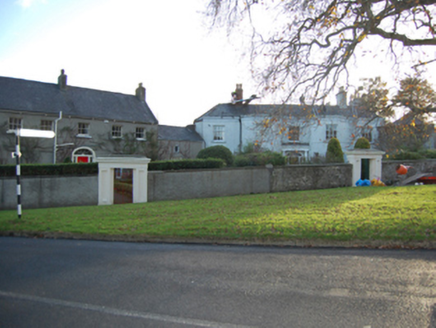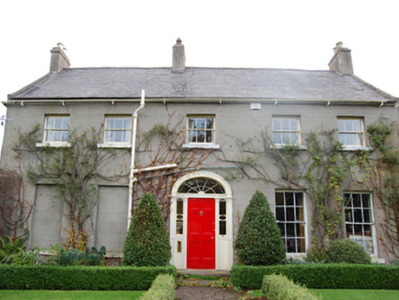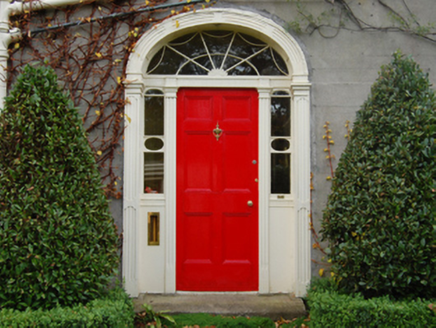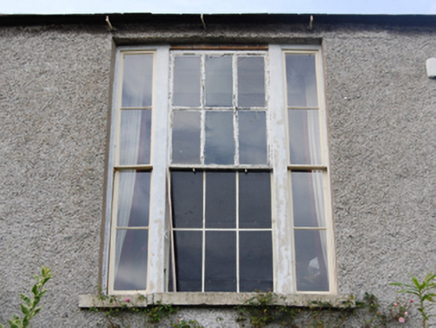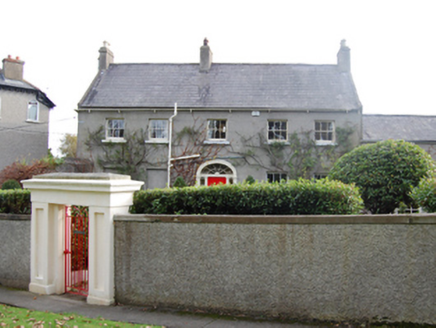Survey Data
Reg No
60260078
Rating
Regional
Categories of Special Interest
Architectural, Artistic, Historical, Social
Original Use
House
In Use As
House
Date
1785 - 1795
Coordinates
324785, 219217
Date Recorded
06/11/2012
Date Updated
--/--/--
Description
Detached five-bay two-storey house, built 1790, on a T-shaped plan with single-bay (single-bay deep) full-height off-central return (south). Occupied, 1911. Sold, 1928. Resold, 1988. Pitched slate roof on a T-shaped plan off-centred on hipped slate roof (south), clay ridge tiles, concrete or rendered coping to gables with rendered, ruled and lined chimney stacks to apexes having stepped capping supporting yellow terracotta tapered pots, rooflights to rear (south) pitch, and cast-iron rainwater goods on wrought iron brackets on rendered eaves retaining cast-iron hoppers and downpipes. Part creeper- or ivy-covered Portland Cement rendered, ruled and lined wall to front (north) elevation; roughcast surface finish (remainder). Elliptical-headed central door opening with cut-granite step threshold, and rendered doorcase with tied reeded pilasters supporting tied reeded archivolt framing timber panelled door having sidelights below fanlight. Square-headed flanking window openings with cut-granite sills, and concealed dressings framing rendered, ruled and lined infill (east) or six-over-six timber sash windows without horns (west). Square-headed window openings (first floor) with cut-granite sills, and concealed dressings framing three-over-three timber sash windows without horns. Interior including (ground floor): central entrance hall retaining carved timber surrounds to door openings framing timber panelled doors, and plasterwork cornice to ceiling; and carved timber surrounds to door openings to remainder framing timber panelled doors with timber panelled shutters to window openings. Set in landscaped grounds with rendered panelled piers to perimeter supporting beaded cornice on blind frieze below blocking course.
Appraisal
A house erected by Thomas Bowen representing an important component of the late eighteenth-century domestic built heritage of south County Dublin with the architectural value of the composition, one forming part of a neat self-contained group alongside the Bowen-built Graigueconna House (see 60260079), suggested by such attributes as the symmetrical frontage centred on a Classically-detailed doorcase not only demonstrating good quality workmanship, but also showing a simple fanlight; the dramatic diminishing in scale of the openings on each floor producing a graduated visual impression; and the high pitched roofline. Having been well maintained, the elementary form and massing survive intact together with substantial quantities of the original fabric, both to the exterior and to the interior, including crown or cylinder glazing panels in hornless sash frames: meanwhile, contemporary joinery; and plasterwork refinements, all highlight the artistic potential of a house having historic connections with the Witty family including Jane Alicia Whitty (1853-1931) and Sophia Angel St. John Whitty (1877-1924), author of "The Flaming Wheel: Nature Studies in the counties of Dublin and Wicklow" (1924; Year's Art 1911, 551).
